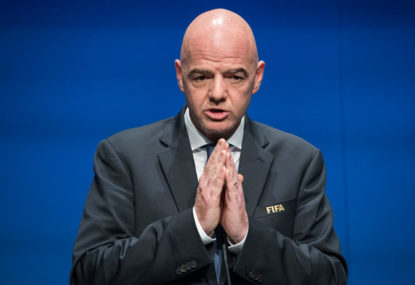Dom
new author
Roar Rookie

The main criticism of FIFA’s newly announced expanded 48-team World Cup format is the quality of competition. The fear is that the prestige of the tournament may be darkened by landslide results due to the arrival of uncompetitive nations.
In the 2002 World Cup, Saudi Arabia lost 8-0 to Germany and in 2010 North Korea lost 7-0 to Portugal. If this was possible in a 32-team competition it’s almost guaranteed in the 48-team format.
Imagine if such a result occurred in the opening fixture of a group stage at the World Cup between Haiti and Sweden with Haiti still to play Brazil. This could quite easily become reality.
In order to reduce the risk of this happening FIFA must be mindful of the quality of teams from certain confederations when readdressing their quotas for entrance into the Cup.
The new quotas are expected to be announced soon but one indication of how FIFA will proceed can be drawn from the FIFA advisory group which included now-President Gianni Infantino back in December 2015.
In a proposed 40-team format, the 39 qualifying spots would have been given as follows:
Europe 14 (13), Africa 7 (5), Asia 6 (4.5), South America 5 (4.5), CONCACAF 5 (3.5), Oceania 1 (0.5), and a final sport awarded “based on sporting merits using a method yet to be defined.”
Using that as a guide for a 48-team competition a reasonable prediction of quotas for 2026 may be:
– Europe (15)
– Africa (9)
– Asia (8)
– South America (6)
– CONCACAF (6)
– Oceania (1)
– FIFA Fair Play (2)
The numbers in brackets are the current quotas.
Using these quotas and the performance of nations in qualifying for the 2014 FIFA World Cup the following additional teams would have qualified.
Europe (2): Ukraine and Sweden
Africa (4): Burkina Faso, Senegal, Tunisia, and Egypt
Asia (4): Uzbekistan, Qatar, Jordan, and Oman
South America (1): Venezuela
CONCACAF (2): Panama and Jamaica
Oceania (1): New Zealand
FIFA Fair Play (2): Haiti and Qatar (two completely random countries)
Here are some nations that didn’t qualify for the 2014 FIFA World Cup nor would they have in my experiment above: Iceland, Romania, Serbia, Wales, Denmark, Czech Republic, Austria, Ireland, Turkey, Slovakia, and Poland.
Which of these teams is going to lose by seven goals? Burkina Faso, Oman or Poland. Would you rather stay up to watch Chile vs Wales or Chile vs Panama?
Of course, the World Cup shouldn’t be an expanded Euro tournament but the addition of more European nations is required to stem fears of too many groups being overtly predictable and non-entertaining.
Without consideration of geographic diversity, Europe could have up to 30 teams in the World Cup. This would turn a great qualification process into a poor one and make the World Cup less-worldly.
SO, I propose more of a compromise between quality and geographical diversity.
Proposed Quotas for the 47 qualifying spots – with the 48th going to the host nation.
Europe (20)
Africa (7.5)
Asia (6.5)
South America (6.5)
CONCACAF (4.5)
Oceania (1)
FIFA Fair Play (1)
This would still increase the geographical diversity of the current tournament but better ensure the quality of the tournament.